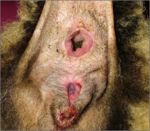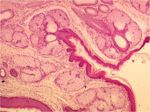Difference between revisions of "Anus - Anatomy & Physiology"
Jump to navigation
Jump to search
Fiorecastro (talk | contribs) |
|||
| (37 intermediate revisions by 5 users not shown) | |||
| Line 1: | Line 1: | ||
| − | + | <big><center>[[Alimentary - Anatomy & Physiology|'''BACK TO ALIMENTARY - ANATOMY & PHYSIOLOGY''']]</center></big> | |
| − | == | + | <big><center>[[Large Intestine - Anatomy & Physiology|'''BACK TO LARGE INTESTINE - ANATOMY & PHYSIOLOGY''']]</center></big> |
| + | |||
| + | ==Introduction== | ||
| − | |||
==Structure== | ==Structure== | ||
| − | [[Image:Sheep Anus.jpg|thumb|right| | + | [[Image:Sheep Anus.jpg|thumb|right|150px|Anus (Sheep) - Copywright RVC 2008]] |
| − | + | *There are ''two'' anal sphincters: | |
| − | There are ''two'' anal sphincters: | + | **'''Internal anal sphincter''', formed by thickening of the circular smooth muscle of the gut and under autonomic control. |
| − | + | **'''External anal sphincter''', formed from striated skeletal muscle and under voluntary control. | |
==Function== | ==Function== | ||
| − | |||
| − | == | + | ==Vasculature== |
| − | |||
| − | |||
| − | + | ==Innervation== | |
| − | |||
| − | === | + | ==Lymphatics== |
| − | |||
| − | |||
| − | |||
==Histology== | ==Histology== | ||
| + | [[Image:Anal Glands.jpg|thumb|right|150px|Anal Glands- Copywright RVC 2008]] | ||
| + | *At the anus, the columnar intestinal epithelium is replaced by the stratified squamous keratinised epithelium of the skin. | ||
| + | *As the muscosa changes from columnar to cutaneous, three zones are created: | ||
| + | **'''Columnar''' | ||
| + | ***Has many longitudinal folds. | ||
| + | ***Divided from the rectum by the ''anorectal line''. | ||
| + | ****This is a line where the mucosa is stratified squamous epithelium containing lots of lymphoid tissue. | ||
| + | **'''Intermediate''' | ||
| + | ***Divided from the cutaneous zone by the ''anocutaneous line''. | ||
| + | **'''Cutaneous''' | ||
| + | ***Skin. | ||
| + | ***Stratified squamous keratinised epithelium. | ||
| + | ***Surrounds the anus. | ||
| + | ***Excretory ducts of the '''anal sacs''' open into this region. | ||
| + | *Sebaceous and apocrine sweat glands are associated with the anal sphincters. | ||
| − | + | ==Species Differences== | |
| − | |||
| − | ''' | + | ===Carnivore=== |
| − | + | *The dog and cat posses two '''anal sacs'''. In the dog, these are the size of a hazlenut. | |
| − | + | **They are located ventrolaterally between the internal and external anal sphincters. | |
| − | + | **The fundus of the sac secretes a potent smelling fluid that drains through a single duct to an opening near the anocutaneous juncntion. | |
| − | + | **The anal sacs get compressed during defecation, which causes the fluid to be expressed. The scent of the fluid is thought to act as a territorial marker. | |
| − | + | ***Large, coiled apocrine tubules. | |
| − | The | + | ***Have many glands in their walls. |
| − | + | ***These glands are tubuloalveolar and produce a fatty secretion. | |
| − | + | ***Anal sacs are clinically important as they are commonly diseased in dogs - frequently, they become enlarged due to accumulated secretion. | |
| − | |||
| − | The | ||
==Links== | ==Links== | ||
| − | |||
| − | |||
| − | |||
| − | |||
| − | |||
| − | |||
Revision as of 15:19, 14 July 2008
Introduction
Structure
- There are two anal sphincters:
- Internal anal sphincter, formed by thickening of the circular smooth muscle of the gut and under autonomic control.
- External anal sphincter, formed from striated skeletal muscle and under voluntary control.
Function
Vasculature
Innervation
Lymphatics
Histology
- At the anus, the columnar intestinal epithelium is replaced by the stratified squamous keratinised epithelium of the skin.
- As the muscosa changes from columnar to cutaneous, three zones are created:
- Columnar
- Has many longitudinal folds.
- Divided from the rectum by the anorectal line.
- This is a line where the mucosa is stratified squamous epithelium containing lots of lymphoid tissue.
- Intermediate
- Divided from the cutaneous zone by the anocutaneous line.
- Cutaneous
- Skin.
- Stratified squamous keratinised epithelium.
- Surrounds the anus.
- Excretory ducts of the anal sacs open into this region.
- Columnar
- Sebaceous and apocrine sweat glands are associated with the anal sphincters.
Species Differences
Carnivore
- The dog and cat posses two anal sacs. In the dog, these are the size of a hazlenut.
- They are located ventrolaterally between the internal and external anal sphincters.
- The fundus of the sac secretes a potent smelling fluid that drains through a single duct to an opening near the anocutaneous juncntion.
- The anal sacs get compressed during defecation, which causes the fluid to be expressed. The scent of the fluid is thought to act as a territorial marker.
- Large, coiled apocrine tubules.
- Have many glands in their walls.
- These glands are tubuloalveolar and produce a fatty secretion.
- Anal sacs are clinically important as they are commonly diseased in dogs - frequently, they become enlarged due to accumulated secretion.

